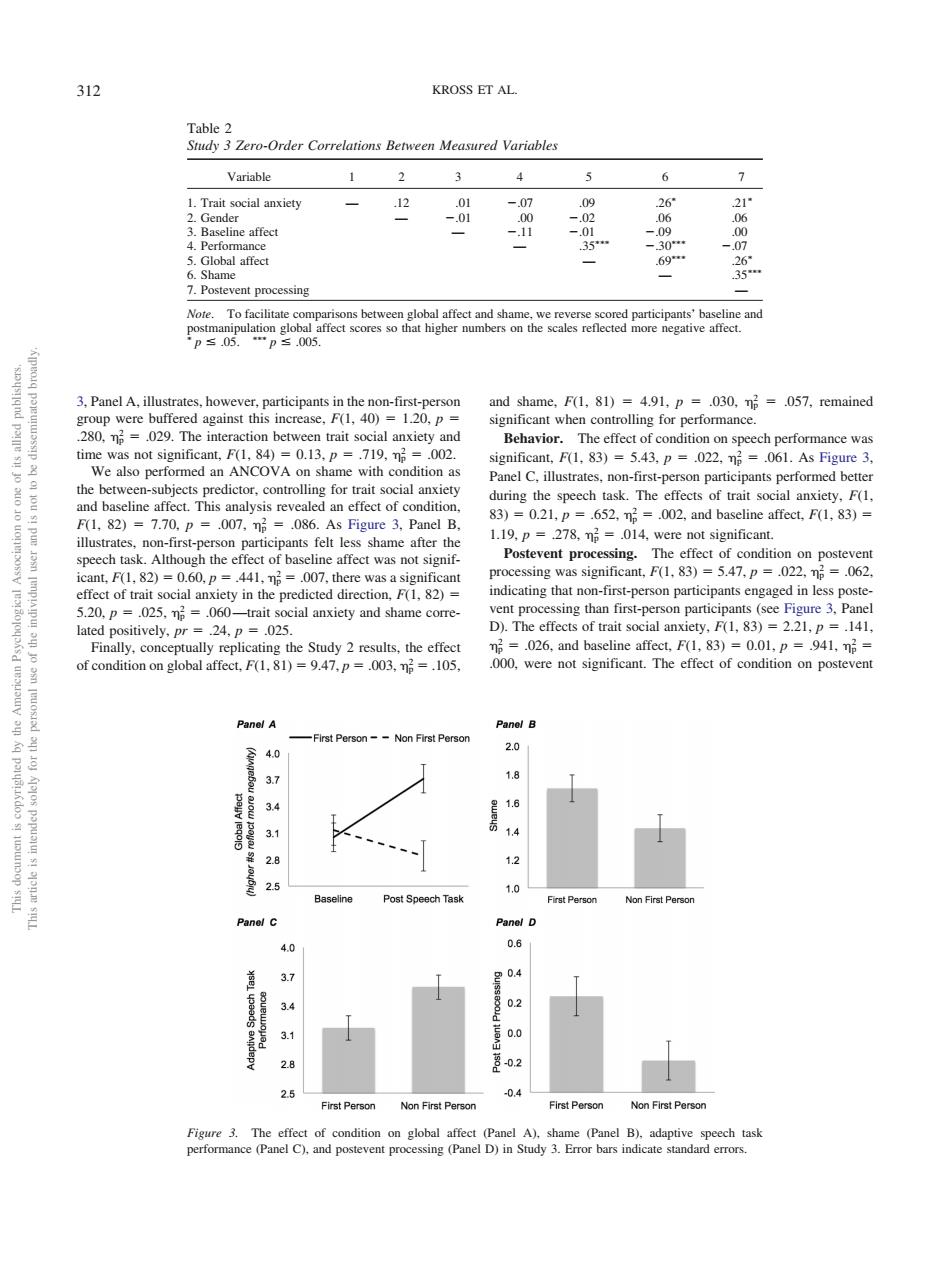正在加载图片...

312 KROSS ET AL Table 2 Study 3 Zero-Order Correlations Between Measured Variables Postevent processing ote.To facilitate Panel A.ill ffered against this increase.)120.p 1g4=013 719. Behavior during the specch task.The effects of trait social anxiety.F( 83)=0.21.p=.652.n2 =.002.and baseline affect.F(1.83) 1,82) .70.p 007..As Figure 3.P e .19.p =.278.=014.were not significant the effect of baselin 20. .025. ocial anxiety and shame corre- F(l.3 P tual m-.026.and baseline affect.F(1.83)0.01.p-941.n of condition on global affect,F(1.81)=9.47.p=003.=.105. 000.were not significant.The effect of condition on posteven irst Person -Non First Pers 40 20 37 18 3 12 10 Post Speech T 06 37 20. 34 0.0 28 5-0.2 25 First Petson Non First Person Non Firs Person3, Panel A, illustrates, however, participants in the non-first-person group were buffered against this increase, F(1, 40) 1.20, p .280, p 2 .029. The interaction between trait social anxiety and time was not significant, F(1, 84) 0.13, p .719, p 2 .002. We also performed an ANCOVA on shame with condition as the between-subjects predictor, controlling for trait social anxiety and baseline affect. This analysis revealed an effect of condition, F(1, 82) 7.70, p .007, p 2 .086. As Figure 3, Panel B, illustrates, non-first-person participants felt less shame after the speech task. Although the effect of baseline affect was not significant, F(1, 82) 0.60, p .441, p 2 .007, there was a significant effect of trait social anxiety in the predicted direction, F(1, 82) 5.20, p .025, p 2 .060—trait social anxiety and shame correlated positively, pr .24, p .025. Finally, conceptually replicating the Study 2 results, the effect of condition on global affect, F(1, 81) 9.47, p .003, p 2 .105, and shame, F(1, 81) 4.91, p .030, p 2 .057, remained significant when controlling for performance. Behavior. The effect of condition on speech performance was significant, F(1, 83) 5.43, p .022, p 2 .061. As Figure 3, Panel C, illustrates, non-first-person participants performed better during the speech task. The effects of trait social anxiety, F(1, 83) 0.21, p .652, p 2 .002, and baseline affect, F(1, 83) 1.19, p .278, p 2 .014, were not significant. Postevent processing. The effect of condition on postevent processing was significant, F(1, 83) 5.47, p .022, p 2 .062, indicating that non-first-person participants engaged in less postevent processing than first-person participants (see Figure 3, Panel D). The effects of trait social anxiety, F(1, 83) 2.21, p .141, p 2 .026, and baseline affect, F(1, 83) 0.01, p .941, p 2 .000, were not significant. The effect of condition on postevent Table 2 Study 3 Zero-Order Correlations Between Measured Variables Variable 1 2 3 4 5 6 7 1. Trait social anxiety — .12 .01 .07 .09 .26 .21 2. Gender — .01 .00 .02 .06 .06 3. Baseline affect — .11 .01 .09 .00 4. Performance — .35 .30 .07 5. Global affect — .69 .26 6. Shame — .35 7. Postevent processing — Note. To facilitate comparisons between global affect and shame, we reverse scored participants’ baseline and postmanipulation global affect scores so that higher numbers on the scales reflected more negative affect. p .05. p .005. Figure 3. The effect of condition on global affect (Panel A), shame (Panel B), adaptive speech task performance (Panel C), and postevent processing (Panel D) in Study 3. Error bars indicate standard errors. This document is copyrighted by the American Psychological Association or one of its allied publishers. This article is intended solely for the personal use of the individual user and is not to be disseminated broadly. 312 KROSS ET AL